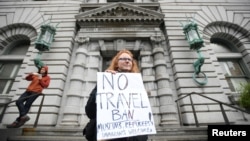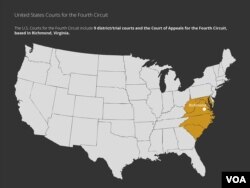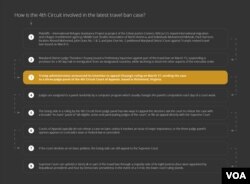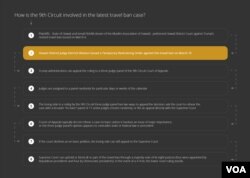While President Donald Trump’s second executive order restricting travel is still on court-ordered hold, it continues to work its way through multiple courts.
A ruling is expected in a Virginia court after hearings were held Tuesday. And in Hawaii, where a district court issued a temporary restraining order hours before the executive order was to take effect March 15, the state is asking for a more permanent hold. A preliminary injunction would halt implementation of the order while the court reviews its constitutionality.
The court has given government lawyers until Friday to respond to the request.
Fourth Circuit
Rather than appeal the Hawaii decision, the Department of Justice requested that an appeals court review a second stay on the travel order issued by a Maryland court.
But the DOJ did not request immediate relief, so the 4th U.S. Circuit Court of Appeals is taking an unhurried approach to its review. The higher court has set an April 26 deadline for DOJ lawyers to file their arguments. The refugee support groups that brought the suit do not have to file until a month after that.
The lack of haste on the part of government, which could have asked for the case to be expedited, seems to contradict Trump’s position that the travel order is urgently needed to protect Americans from terrorist activity.
“It does tend to undercut any claim that the executive order is responding to some clear and present danger to national security. If that were the case, it’s hard to imagine that the government would sit around for days and days before trying to get the order implemented,” wrote immigration lawyer Pamela Karlan in response to a VOA query. Karlan is a professor of public interest law at Stanford Law School.
White House Press Secretary Sean Spicer said at a press briefing last week that the government would “vigorously defend this executive order,” both in Maryland and Hawaii.
Ninth Circuit
A week after U.S. District Judge Derrick Watson issued the stay in Hawaii, the administration has yet to appeal it. The Hawaii appeal would have to be made to the 9th U.S. Circuit Court of Appeals, which upheld a stay on the first travel order. Rather than pursue that case in the appeals court, Trump signed the second travel order March 6.
The second order barred the issuance of new visas for 90 days to people from six countries: Somalia, Iran, Syria, Sudan, Libya and Yemen. Iraq, which had been on the list in the first travel order, was omitted because it agreed to stricter vetting. Like the first travel order, the second one barred refugee admissions for 120 days, but it did not ban Syrian refugees indefinitely, as the first one did.
Critics of the first travel order, who said it amounted to a Muslim ban, were not appeased by the new version. Hawaii sued the government on the grounds that the travel order would harm the state’s Muslim population, as well as tourism and foreign students.
In his opinion, Watson said the case before him included “significant and unrebutted evidence of religious animus driving the promulgation of the executive order and its related predecessor.”
In Washington State, where the second ban also is being challenged, U.S. District Court Judge James Robart put a stay on proceedings for as long as the Hawaii court’s nationwide temporary restraining order remains in place, to “conserve resources.”
















